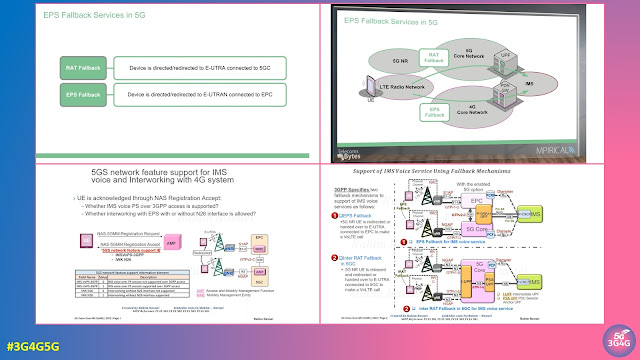It can be expected that later this year some mobile network operators will launch their initial 5G standalone (5G SA) deployments.
Nevertheless there will remain areas with temporary or permanently weak 5G NR coverage. One possible reason might be that even when 5G and LTE antennas are co-located, which means: mounted at the same remote radio head, the footprint of the 5G NR cell is significantly smaller when it uses a higher frequency band than LTE - see figure 1.
 |
| Figure 1: Smaller footprint of co-located 5G NR cell with higher frequency |
Especially UEs making Voice over New Radio (VoNR) calls from the 5G cell edge have a high risk of experiencing bad call quality, in worst case a call drop. To prevent this the UE is forced during the voice call setup towards 5G core network (5GC) to switch to a LTE/EPS connection where the radio conditions are better for the voice service.
The same procedure for which the term "EPS Fallback" was coined by 3GPP also applies when the UE is served by a 5G cell that is not configured/not optimized for VoNR calls or when the UE does not have all needed VoNR capabilities.
 |
| Figure 2: Two options for EPS fallback |
When looking at the RAN there are two options for executing the EPS Fallback as shown in figure 2.
In option A the 5G radio connection is released after the initial call attempt is successfully finished and with the 5G RRC Release the UE is ordered to reselect to a 4G cell where a new radio connection is started for the VoLTE call. In this case the UE context is transferred from the AMF to the MME over the N26 interface. 3GPP seems to use also the term "RAT fallback" for this option.
Option B is to perform a 5G-4G inter-RAT handover. Here the session management and user plane tunnels in the core network are handed over from SMF/UPF to MME/S-GW in addition. This is realized with the GTPv2 Forward Relocation procedure on N26 interface.
All in all the EPS fallback is expected to cause an additional call setup delay of approximately 2 seconds.
For the inter-RAT handover case it is easy to detect from signaling information that an EPS fallback was triggered. In the source-eNodeB-to-target-eNodeB-transparent-container sent by the gNB to the eNB a boolean "IMS voice EPS fallback from 5G" indicator will be found that is set to "true". This container is named according to the receiving entity and will be carried by the NGAP Handover Preparation, GTPv2 Forward Relocation Request and the S1AP Handover Request messages.
If a redirection for Voice EPS Fallback is possible or not is indicated in the NGAP Initial Context Setup Request, Handover Request (during 5G intra-system handover) and Path Switch Request Acknowledge (after Xn handover) messages, all sent by the AMF to the gNB.
Further the NGAP protocol provides the cause value "IMS voice EPS fallback or RAT fallback triggered" in the PDU Session Resource Modify Response message indicating that a requested VoNR session cannot be established.
An excellent, very detailed description of N26 interface functionality and testing ia available
here.





